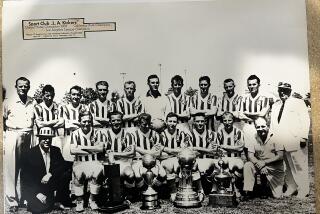Tournament at Turning Point : Tennis: L.A. Open copes with lean times in an effort to continue its tradition.
They’re serving grilled chicken Caesar salads and tennis balls at the Los Angeles Open, once the tournament of Tilden, Vines, Budge, Kramer, Laver, Gonzalez, Ashe, Connors and McEnroe.
It looked for a while like today’s champion was going to be some guy who learned how to play tennis on a court made out of an ant bed.
Tennis is the great equalizer, all right, caring not one whit where you come from, only how often you can hit a line with a ball.
But Los Angeles tennis seems to be at a turning point. The men’s event has no title sponsor to provide funding when Volvo ended a nine-year association and this week’s women’s tournament is expected to be the last Virginia Slims of Los Angeles.
There are talks under way about combining the men’s and women’s events in back-to-back tournaments next year at UCLA.
Sponsor’s dollars might be getting off the tennis court faster than, say, Boris Becker’s first serve, but the L.A. Open is a fast learner on how to cope with a recession.
“We’re going to be fine,” said Jack Kramer of the tournament committee.
Tournament director Bob Kramer said the tournament could lose money. “We’re fighting to break even and the tournament may come up short.”
If so, it’s not because Kramer didn’t try most everything he could. When the ATP took control of the men’s game in 1990, the tournament became a so-called World Series event, smaller than the Championship Series events that offer $1.7 million in prize money.
Such a designation means that the tournament can offer appearance fees to attract star players. Although this was a common tennis practice in the past, it was not sanctioned and was done under the table.
For this tournament, four players--Becker, Andre Agassi, Michael Chang and Richard Krajaicek--signed incentive-based contracts that could have been worth about $600,000.
Becker’s is the richest. If he defeats Mark Woodforde today to win the tournament, he can earn as much as $200,000.
Jason Stoltenberg, who first played tennis on the ant hill court in Australia, lost to Becker in Saturday night’s semifinals. Stoltenberg ended Agassi’s tournament in the quarterfinals. Agassi could have earned $150,000 by winning the tournament.
Bob Kramer said the contracts with the players were based on Grand Slam event results and rankings in addition to how far each player advanced.
Each player receives a flat fee and additional money for reaching the semifinals, the final and for winning.
“The good thing about having contract players is that you have some control over what they do, like interviews or maybe some corporate hospitality or something,” Kramer said.
Kramer and Ivan Blumberg of ProServ, which has an association with the tournament, targeted Becker and Agassi more than a year ago.
“Let’s face it, Becker and Agassi are two people who fans will get out of their chairs at home to see play,” he said.
All that was left was to draw up the contracts and see if Becker could claim his $200,000 or Agassi his $150,000. Prize money for winning the tournament is $42,000, or about one-fifth of Becker’s appearance deal.
Jack Kramer said the idea of paying players $600,000 for the chance to win a $42,000 check strikes him as sort of cockeyed, but he understands.
“You’ve got to do something to get star players or the tournaments are going to die,” he said.
At the old Los Angeles Tennis Club, where Tilden and Vines and the rest began the tournament’s great tradition, Kramer remembered grand buffet lunches served on white linen tablecloths.
“It was a different era,” he said.
The new one is well under way.
More to Read
Go beyond the scoreboard
Get the latest on L.A.'s teams in the daily Sports Report newsletter.
You may occasionally receive promotional content from the Los Angeles Times.










